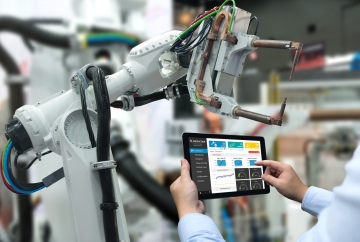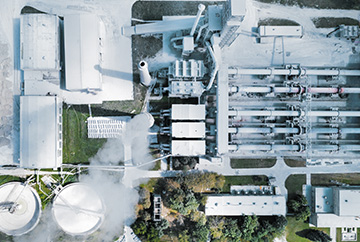Let’s begin by understanding the role of IoT in industrial automation.
What Is IoT In Industrial Automation?
IoT devices are smart devices connected to the internet. They’re equipped with sensors to communicate with other connected devices.
Industrial IoT or IIoT refers to IoT solutions leveraging the potential of artificial intelligence, machine learning, and robotic process automation in manufacturing, supply chains, management systems, and other commercial settings.
IoT technology in industrial automation is the key to smart manufacturing and intelligent process control as it:
- Enhances operational efficiency
- Saves costs and improve margins
- Optimizes raw material and energy consumption
- Reduces time-to-market
IoT platforms are crucial to taking full advantage of IoT devices. An IoT platform is cloud-based and manages vast amounts of operational data extracted from IoT sensors in real-time. This capability makes it easier to access all industrial data, run analytics, and draw useful insights for decision-making.
Let’s look at some of the top use cases and applications of IoT technologies in industries.
IoT Applications in Smart Factory Automation
- Real-time production monitoring and tracking
- Smart glasses
- Industrial analytics
- Predictive maintenance
- Quality assurance
- Health, safety, and environment
- Reconfiguration and rescheduling for operation performance optimization
- Dynamic work instructions and AR for operation execution and process enforcement
- Material flow, internal and external logistics, and process tracking for material pull
- OEE and energy consumption monitoring
- Smart Lighting and HVAC control
- Remote and condition monitoring, component-level anomaly detection
- Optimal workload planning for improved sustainability and reduce repair cost
- Integration with EAM, ERP, SCADA/Historian for asset life cycle performance management
- Feed intelligence back into product design and process planning implementing Product Twins intelligencev
- Synchronize and optimize asset life cycle process information implementing Asset Twin intelligence
- Production performance monitoring and process control
- Continuous product improvement through scenarios-based results and analytics
- Wearable tech to keep workers safe
- Augmented reality and virtual reality in training and remote support
- Real-time fleet management for timely last-mile deliveries
- Smart warehousing
1. Real-time production monitoring and tracking
One of the top challenges that manufacturers face is the complete visibility of the production floor. IoT sensors on industrial equipment and machinery can paint a full picture of the production process in real-time. Continuous production monitoring and tracking help plant managers know which machines function at capacity and spot the underperforming ones.
2. Smart glasses
Smart glasses are a great way to view instructions hands-free, perform real-time situation awareness, and ensure worker safety. They assist factory workers with real-time tracking, alerts, insights, recommendations, and automated reporting.
For instance, production floor workers can examine layouts, assemble guidelines, equipment logs, status, and performance on the go without logging into their laptops or tablets. It reduces delays, simplifies work procedures, and improves shop floor productivity.
3. Industrial analytics
Making sense of vast amounts of IoT data is another challenge that manufacturers face. Industrial IoT solutions facilitate data analytics, even on edge devices, to quickly process and interpret operational data. This facet empowers plant managers to make data-driven decisions for several manufacturing plants with no delays.
4. Predictive maintenance
Big data analytics and IoT sensors combine historical data and real-time performance monitoring to send smart alerts or notifications whenever an equipment’s efficiency and health condition drops below a set threshold. Such alerts enable predictive maintenance by helping technicians spot issues like an imminent component failure. It reduces unplanned downtime in factories, which can be costly and lead to missed deadlines.
5. Quality assurance
Quality assurance is crucial to:
- Maintain an enterprise’s reputation
- Enhance customer experience
- Ensure customer loyalty
- Avoid hefty fines because of regulatory compliance violations
IoT devices can automate quality checks by constantly monitoring the production floor and sending real-time logs to QC (quality control) managers. According to McKinsey, advanced image recognition or AI-based visual inspection can improve fault detection rates by up to 90% compared to human review.
6. Health, safety, and environment
Industrial environments can cause dangerous scenarios or accidents that lead to serious workplace injuries. IoT sensors can continuously monitor aspects such as equipment performance, energy use, environment temperature, and the presence of toxic gases or radiation. IoT platforms in industries can also facilitate automated disaster response systems. Such technologies help guarantee employee health and safety.
7. Reconfiguration and rescheduling for operation performance optimization
AI-based real-time optimization models can improve performance through smarter processes and better operation of heavy machinery. With machine learning models in a closed loop that adjust machinery as per changes in the environment, manufacturers have saved energy and increased operational capacity.
8. Dynamic work instructions and AR for operation execution and process enforcement
Using location-based tracking, shop floor automation platforms powered by IoT can provide dynamic work instructions automatically. It streamlines workflows and enables automatic rescheduling of jobs as per changes in the workflow.
AR-enabled platforms take efficiency a step further by allowing operators to integrate digital mock-ups with actual production environments, making operation execution and inspection quick and seamless.
9. Material flow, internal and external logistics, and process tracking for material pull
IoT devices can help with inventory management by tracking material flow with RFID tags and saving inventory costs with just-in-time logistics. According to McKinsey, IIoT can reduce inventory levels by up to 36% percent.
For instance, IoT sensors can spot container-fill levels with ultrasound. So, the logistics team can track raw material consumption more accurately and coordinate supply and production to reduce the overstocking of inventories and reduce waste.
10. OEE and energy consumption monitoring
IoT sensors can track equipment availability, performance, product quality, and other factors to determine production floor OEE.
The sensors can also track energy and raw material consumption and send alerts whenever there’s wastage. These technologies also help plant managers figure out ways to improve OEE continuously by monitoring processes and workflows and spotting opportunities.




